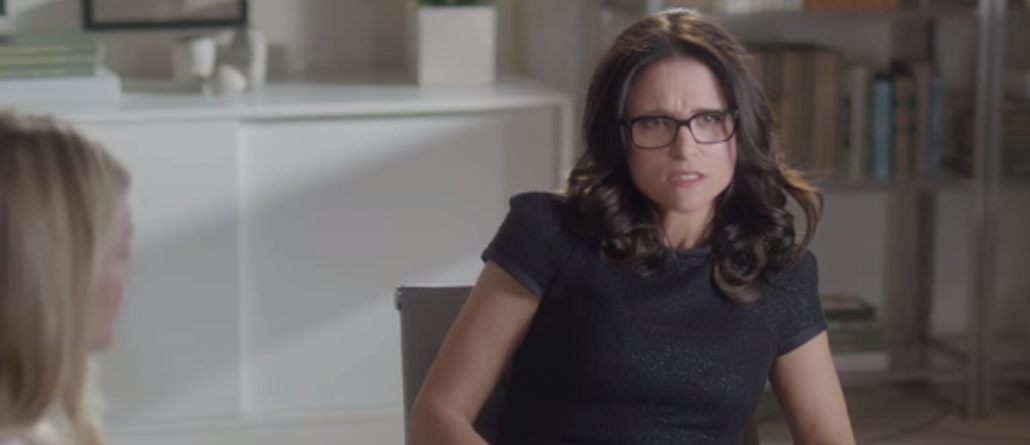Save 50% on a 3-month Digiday+ membership. Ends Dec 12.

For Old Navy, YouTube is a way to show a funnier, looser side of the brand rather than going for the hard sell.
Its strategy revolves around TV ad outtakes starring spokeswomen Amy Poehler and Julia Louis-Dreyfus. Poehler’s outtakes reached 500,000 views online, and while her commercials and outtakes got a lot of play, they’re now hidden from Old Navy’s YouTube channel as Louis-Dreyfus’s campaign is currently active. Both TV campaigns turned the women into slightly deranged, Old Navy-obsessed versions of themselves. On YouTube, however, the brand’s posted outtake clips to its channel, letting their spokeswomen shine, without promoting products.
Richard Christiansen, founder and creative director of Chandelier, worked with Old Navy for both its YouTube and Tumblr campaigns. He said that while filming with Poehler and Louis-Dreyfus, they were able to have more fun, and therefore, ended up with more fodder than they could fit in the standard commercials.
“Broadcast asks the commercials to do a lot of heavy lifting: include humor, urgency and sell a product,” said Christiansen. “On set, we would get great footage, and now [with the outtakes] we can continue the conversation and entertain people online, not just sell them stuff.”
This approach has helped Old Navy amass a strong YouTube following for a retailer, with more than 17,000 subscribers. (Comparably, Gap has 6,000, Kohl’s has 13,000, Banana Republic has 2,000 and T.J. Maxx has a little over 1,000.)
Other retail YouTube channels fail to strike the chord that Old Navy’s does by combining cut TV footage, popular actresses and organic content. For example: Banana Republic posts behind-the-scenes clips from photo shoots; Gap’s channel is filled with the failed “Dress Normal” fodder; J.Crew hasn’t posted a YouTube video since the holidays.
“Old Navy’s recognized that they don’t need to double up on the hard sell,” said Tim Nolan, creative director at Huge (which did not work with Old Navy on its campaigns). “It builds an affinity for the brand when you can watch something that’s purely entertaining and fun, beyond talking about the clothing. That’s to the credit of Old Navy – they’re just giving people something funny to watch.”
Old Navy’s sales numbers are on the upswing. Earlier this month, Gap Inc. announced its sales numbers for March, and while the company (which owns Gap, Old Navy, Banana Republic, Athleta, Piperlime and Intermix) as a whole saw a slight uptick in revenue over the same time period last year, Old Navy showed the strongest improvement: Comparable sales for March rose 28 points from negative 7 percent to 14 percent in 2015 (Gap, for comparison, was flat at negative 7 percent).
In 2014, Old Navy’s comparable sales came in at 5 percent, rising from 2 percent in 2013. The brand didn’t respond to requests to comment for this article.
According to Nolan, consumers are more likely to spend their time online watching engaging content rather than straightforward advertisements. The most recent outtake on Old Navy’s YouTube channel, from Louis-Dreyfus’s ad “The New Boyfriend Goes to Couples Therapy,” has over 300,000 views.
Nolan attributes the YouTube success to the human – and celebrity – element brought in by Poehler and Louis-Dreyfus. Old Navy’s previous campaign, the “Supermodelquins” was a “funny gag,” said Nolan, but one that grew cold with mannequins as its focal point.
According to Cedric Devitt, chief creative officer at Big Spaceship, digital ads should be a “no brainer,” especially when familiar celebrities are involved.
“Digital, not TV, is the more effective media to engage with the millennial audience,” said Devitt. “TV can appeal to the broader audience, but the YouTube content is more snackable. It’s less architected. What didn’t make it on TV is more interesting to [the millennial audience]. It has more edge.”
Since December, Old Navy’ has also been using Tumblr to publish content and videos, and has recently been sharing spring style tips starring fashionista Jamie Chung. Whereas Old Navy’s presence on Tumblr and Instagram appeals overtly to the female consumer, the YouTube ads tap into a more general audience (even if they’re most prominently promoting items like dresses and boyfriend jeans).
According to Devitt, the brand’s content on social is targeted at their core followers – women – but on YouTube, the videos don’t have the same narrow focus. “It’s comedy. That’s the middle ground – they want to skew toward men and women,” said Devitt.
“The brand is doing really well right now; sales are strong,” Christiansen said. “I think that’s happening because the brand has become a lot more relevant and current, through creative producing and sharing. People are engaged digitally.”
More in Marketing

How Costco stood against Trump’s agenda on tariffs, DEI this year
Costco has continuously been held up as an example of a company that has stood firm in its willingness to do what it believes is best for the business.

Brands look to experiential marketing as antidote to AI slop, digital fatigue
Brands are prioritizing experiential and IRL marketing as an antidote to ‘AI slop’ and digital fatigue.

Agencies push curation upstream, reclaiming control of the programmatic bidstream
Curation spent much of this year in a fog, loosely defined and inconsistently applied. Agencies say they plan to tighten the screws in 2026.





